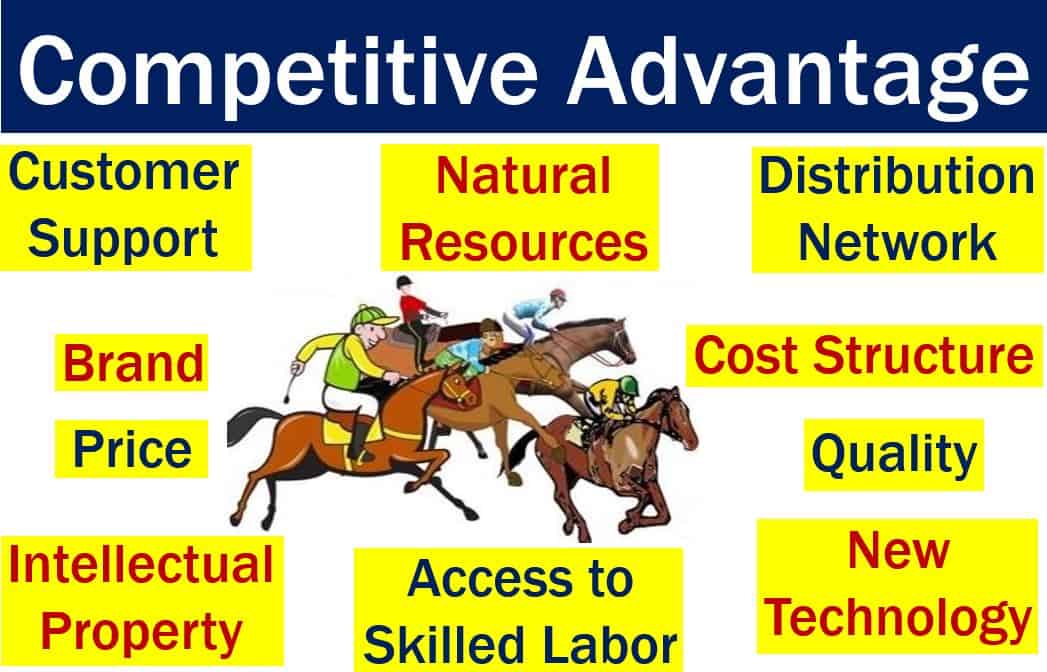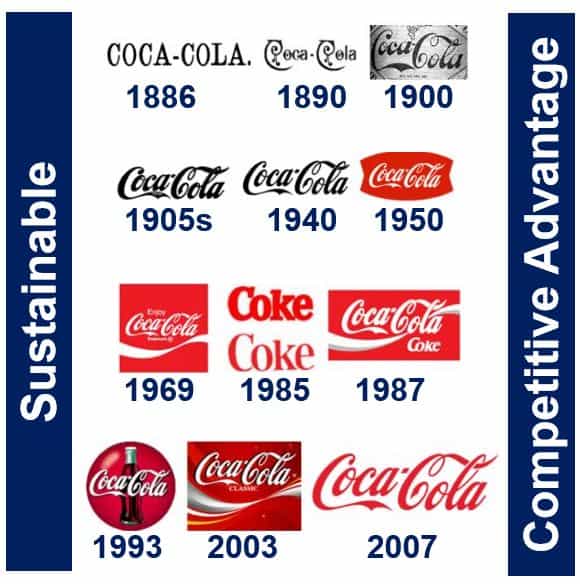Competitive Advantage is a feature that gives a company an edge over its rivals. It is something that helps it compete more effectively. A competitive advantage could be a superiority that a company gains. For example, perhaps it can provide the same value as other companies can, but at a lower price. It may also offer more attractive credit terms than its competitors.
Some companies with a competitive advantage can charge more. They charge more by providing greater value through differentiation. Differentiation refers to the results of efforts to make a brand stand out to customers. Specifically, it stands out as a provider of unique value.
We can use the term ‘competitive advantage’ at individual, company, or country levels. This article focuses on its meaning at company level.
Specifically, the article focuses on conditions that allow companies to generate either greater margins or superior sales than their rivals.

When a company sustains greater-than-average profits, we say it possesses a competitive advantage over its competitors. The goal of most firms is to achieve a sustainable competitive advantage.
Do not confuse the term with ‘comparative advantage.’ Comparative advantage refers to nations becoming wealthier by trading rather than becoming self-sufficient. In other words, they specialize, trade with other nations, and get richer.
Competitive advantage – reasons
A firm may have a competitive advantage due to its quality, price, brand, distribution network, intellectual property, or location.
It could also be due to customer support, cost structure, natural resources access, and a supply of suitably-skilled labor.
Historically, access to new technology has consistently given companies a significant advantage over their rivals.
In the digital age, data analytics and customer insights play a crucial role in shaping competitive advantage, allowing companies to anticipate market trends and customer needs more accurately.
Competitive advantage provides an edge over the competition. It can also generate more value for a business and its shareholders.
In customers’ minds, a competitive advantage is what makes a company superior to others. Businesses first utilized this ‘competitive advantage’ method of success. However, any person or entity can also adopt it.
The rise of sustainable business practices and corporate social responsibility is increasingly influencing consumer choice, allowing companies with strong ethical commitments to differentiate themselves in crowded markets.
Competitive advantage – three determinants
Before finding out what your competitive advantage is, you need to know about three determinants. First, the competition; second, what you produce; and third, the target market.
Your Target Market
Which customers should you target? You must know who is currently buying from you. You also need to find out who will purchase from you in the future.
Furthermore, you must determine what you need to do to make them happier. In other words, find out how can get them to spend more.
For example, physical newspapers today know that their target market is older individuals. They know this because younger adults prefer going online. Many newspapers did not prepare for this evolution and consequently died.
What Are You Providing?
You must be clear on what type of product you are providing. Only then can you focus on making sure it is something that offers real value.
You need to list all the advantages and benefits that your product provides consumers.
For example, since the Internet emerged, retailers have had to redefine what a shopping experience is for the customer.
The Competition
You need to know everything about rival companies. You also need to find out as much as you can about your customers. Then you have to try to meet their particular needs.
Major retailers thought their competition was other major retailers. However, it was, in fact, the online world.
Suddenly, the market opened up to millions of smaller players. Operating online means having considerably lower costs than retailers with physical shops. Online retailers are forever looking for innovative ways of enhancing the shopper’s experience.
Make sure you are completely familiar with every aspect of these three determinants. They will help you identify what you are better able to provide to your target market than your competitors. Being able to do that is your main competitive advantage.

Value proposition
When understanding competitive advantage, value proposition is important. A value proposition is a summary of why a consumer should buy a product. We also use value propositions for services.
If the value is effective, it may produce a competitive advantage in the good or service.
The value proposition will also increase customer expectations and choices.

Competitive advantage – two types
American academic, Michael Porter, famous for his economic and business theories, identified two basic types of competitive advantage: First, Cost Advantage; and second, Differentiation Advantage.
Cost Advantage
Cost advantage exists when a company can deliver the same benefits as its competitors. However, it does so at a lower price.
It can achieve this with superior technology, efficient processes, waste reduction or elimination, and a skilled workforce. A favorable location and access to cheaper inputs also help.
Differentiation Advantage
Differentiation advantage is when a company delivers more benefits than its competitors. In other words, the company’s unique features set it apart and above those of its competitors. Differentiation advantage may refer to a company, product, or service.
Prof. Porter published his book – Competitive Advantage – in 1985, as the ‘essential companion’ to his earlier work – Competitive Strategy (1980). While ‘Competitive Strategy’ looked at competition at industry level, ‘Competitive Advantage’ considered it from a company’s-eye view.
Prof Porter said:
“My quest was to find a way to conceptualize the firm that would expose the underpinnings of competitive advantage and its sustainability.”

Is competitive advantage dead?
What usually happens when one academic coins a phrase or comes up with a new theory? A few years later another professor tries to kill it.
According to Rita Gunther McGrath in her 2013 book The End of Competitive Strategy: How to Keep Your Strategy Moving as Fast as Your Business, the traditional notion of strategy (as a means to secure a sustainable competitive advantage) is increasingly outdated.
She argues that most existing strategy frameworks are built on the idea that the goal of strategy is to establish and maintain a long-term, defensible market position. In contrast, McGrath contends that this approach no longer fits many modern companies.
In the past, strategy was focused on identifying a favorable position within a clearly defined industry and leveraging that position over time, while innovation was treated as a separate, complementary activity aimed at creating new business opportunities.
Today, however, demands a more dynamic and integrated approach where strategy and innovation are continuously aligned with the pace of the market.
Prof. McGrath argues that competitive advantage is not sustainable. In other words, it is transient. To operate, we need a new series of assumptions about how the global marketplace works. We also need ‘a new playbook to compete and win when competitive advantages are transient,’ she said.
Basing one’s strategy on a new set of assumptions may not seem very appealing. This is especially the case for managers who are still ‘stuck’ in the old economy.
Absolute advantage refers to what one entity can produce at a better rate than another. Imagine John Doe Inc. produces three shirts per worker per day, and Mary Ltd. produces four shirts per worker per day. Mary Ltd. has an absolute advantage over John Doe.
Compound phrases containing “advantage”
Apart from competitive advantage, comparative advantage, and absolute advantage, there are many compound phrases in business English containing the word “advantage.” Let’s have a look at some of them:
Cost Advantage
AA company’s ability to produce at a lower cost.
Example: “The company’s cost advantage allowed it to undercut the prices of its competitors, winning a larger market share.”
Technological Advantage
Superiority in using advanced technology.
Example: “With its technological advantage, the startup was able to disrupt the traditional market with its innovative app.”
First-mover Advantage
Benefits of being the first in a new market.
Example: “The company’s first-mover advantage secured its position as the leading provider before other potential competitors entered the space.”
Brand Advantage
Recognition and esteem of a company’s brand.
Example: “Due to its brand advantage, customers are willing to pay a premium for their products over lesser-known brands.”
Strategic Advantage
A unique and hard-to-imitate business approach.
Example: “Their strategic advantage stems from a unique partnership with suppliers that gives them priority access to high-demand materials.”
